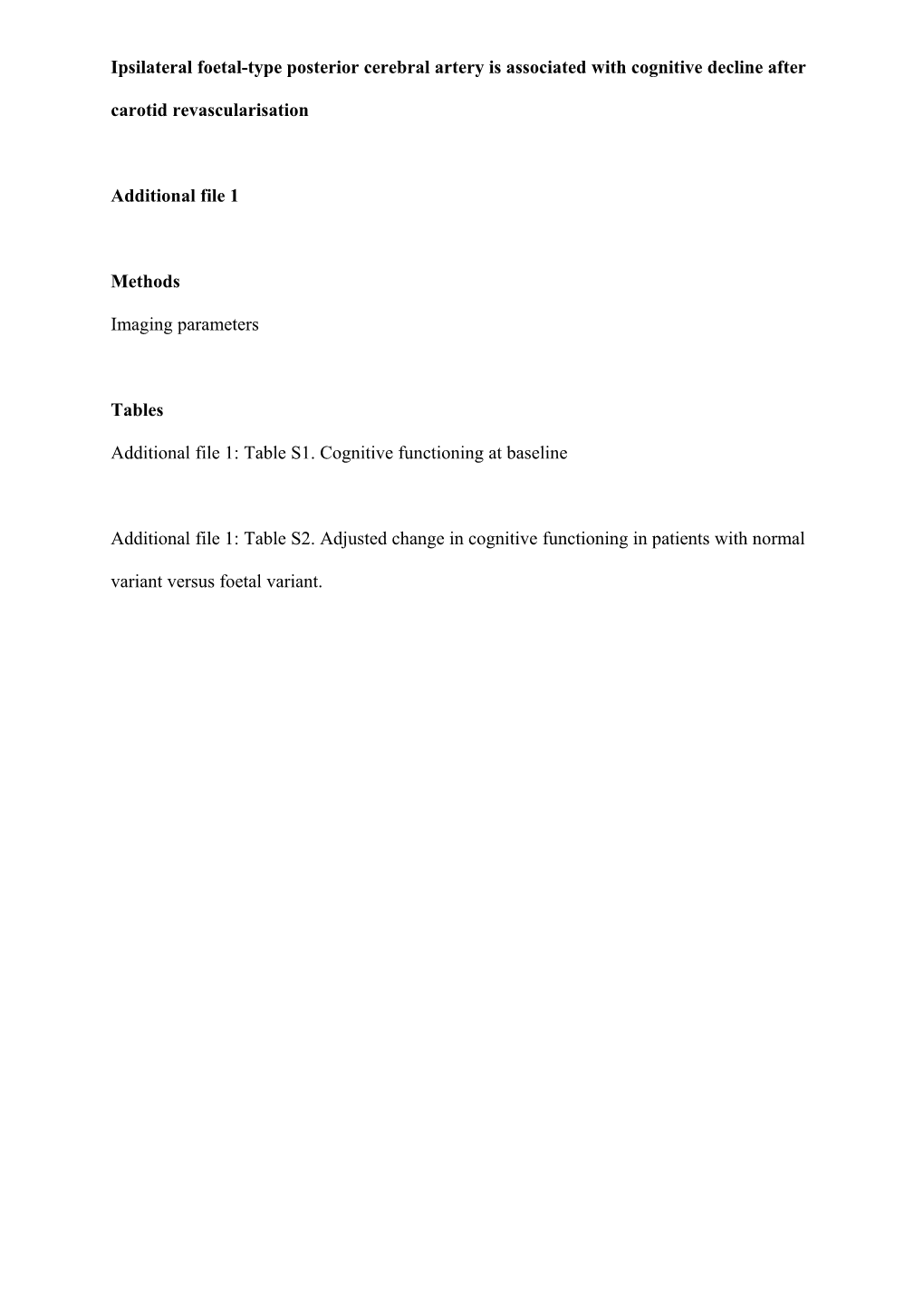Ipsilateral foetal-type posterior cerebral artery is associated with cognitive decline after carotid revascularisation
Additional file 1
Methods
Imaging parameters
Tables
Additional file 1: Table S1. Cognitive functioning at baseline
Additional file 1: Table S2. Adjusted change in cognitive functioning in patients with normal variant versus foetal variant.
Methods
Imaging parameters
CTA was performed with a 16- or 64 row scanner (Philips Medical Systems, Best, the Netherlands) after injection of 50 mL contrast material at 5 mL/s, followed by a saline chaser bolus of 50 mL injected at the same flow rate. A 64x0.625 mm collimation was used, with a pitch of 0.672 and a rotation time of 0.40 seconds. Exposure settings were 80/120 kVp and 300/95 mAs. Overlapping sections of 1.0 mm (16-slice) or 0.9 mm slice thickness (40 or 64- slice) were reconstructed at a reconstruction interval of 0.5 mm and a field of view of 160 mm.
MRA was performed on 1.5 or 3.0 Tesla scanners (Philips Medical Systems, Best, the Netherlands) with a quadrature head coil for signal-intensity reception. The imaging protocol consisted of a 2D phase-contrast sagittal localizer survey through the circle of Willis, followed by a 3D-TOF MRA sequence with the following parameters: TR, 23 ms; TE, 3.5 ms; flip angle, 18°; sensitivity encoding factor, 2; FOV, 200 x 200 x 100 mm; matrix, 304 x 200 with 100 sections; reconstructed voxel size, 0.39 x 0.39 x 1.00 mm; and acquisition time, 2 minutes 57 seconds.
Additional file 1: Table S1: Cognitive functioning at baseline
Test (n normal PCA, n foetal-type PCA) / Normal PCA / Foetal-type PCA(n=96) / (n=16)
Cognitive sum z-score* (96,16) / -0.19 (0.83) / -0.42 (0.72)
Baseline domain z-scores and raw test scores
Abstract Reasoning z-score (64,13) / -0.33 (0.79) / -0.62 (1.07)
Raven Advanced Progressive Matrices, short form (63,13) / 6.1 (2.5) / 4.9 (3.4)
WAIS similarities (64,13) / 18.8 (6.4) / 17.5 (7.6)
Attention z-score (95,16) / 0.68 (1.33) / 0.19 (1.24)
WAIS III Digit Span Forward (95,16) / 8.0 (2.2) / 6.9 (1.8)
Visual Elevator of the Test of Everyday Attention* (75,11) / 7.1 (2.8) / 6.1 (3.1)
Executive Functioning z-score (90,16) / -0.48 (0.70) / -0.73 (0.60)
Brixton Spatial Anticipation Task (86,16) / 20.9 (6.7) / 24.8 (5.9)
Letter Fluency† (87,16) / 9.2 (4.3) / 8.2 (3.5)
Language z-score (96,16) / -0.47 (1.11) / -0.67 (0.90)
Token Test, short form (89,16) / 16.4 (3.8) / 15.4 (3.9)
Boston Naming Test, short form (95,16) / 76.9 (12.5) / 75.9 (9.3)
Verbal Memory z-score (94,16) / -0.03 (1.15) / -0.17 (0.76)
WAIS III Digit Span backward (94,16) / 5.1 (2.2) / 4.6 (2.3)
Rey Auditory Verbal Learning Test‡ (93,16) / 19.8 (5.9) / 19.8 (5.0)
Semantic Fluency (86,16) / 26.3 (10.3) / 23.9 (5.7)
Visual Memory z-score (89,16) / -0.11 (0.90) / -0.16 (1.13)
Rey-Osterrieth Complex Figure-delay (89,16) / 15.5 (6.0) / 15.2 (7.6)
Visual Perception z-score (94,16) / -0.33 (0.93) / -0.70 (0.97)
Benton Judgment of Line Orientation, short form (88,15) / 22.6 (5.9) / 21.9 (7.3)
Facial Recognition Task, short form (89,16) / 43.2 (4.7) / 42.8 (3.8)
Rey-Osterrieth Complex Figure-copy (91,16) / 32.1 (5.0) / 29.0 (5.3)
Premorbid and current cognition
Informant Questionnaire of Cognitive Decline / 2.96 (0.36) / 3.02 (0.20)
Estimated premorbid Intelligent Quotient (NART) / 76.1 (21.4) / 71.2 (14.8)
MMSE / 26 [25-28] / 26 [24-27]
Premorbid anxiety/depression
STAI / 40.2 (12.5) / 38.9 (11.5)
STAT / 34.4 (9.8) / 30.2 (10.8)
BDI / 7.2 (6.5) / 6.2 (5.2)
Data are mean (SD) or median [range]. *Cognitive scores are expressed as units of standard deviations (z-scores) from the mean in a normal reference population, with negative values expressing scores below the normal population mean. *= mean of the visual elevator accuracy and timing score. †=mean of total words produced beginning with letter “N” or “A”. ‡= mean of the total direct, delayed, and recognized word count. CAS, carotid artery stenting; CEA, carotid endarterectomy; WAIS, Wechsler adult intelligence scale; NART, national adult reading test; MMSE, mini mental state examination; STAI, state-trait anxiety inventory (state); STAT, state trait anxiety inventory (trait); BDI, Beck’s depression inventory.
Additional file 1: Table S2. Adjusted change in cognitive functioning in patients with normal variant versus foetal variant
Mean Difference / (95% CI)
Unadjusted cognitive sum z-score / -0.20 / (-0.40 to -0.01)
Additional adjustment
Age (years) / -0.20 / (-0.40 to -0.01)
Sex / -0.20 / (-0.40 to -0.01)
Education / -0.20 / (-0.39 to 0.00)
Side stenosis* / -0.22 / (-0.41 to -0.02)
Treatment / -0.20 / (-0.39 to -0.00)
Treated hypertension / -0.20 / (-0.40 to -0.00)
CABG / -0.20 / (-0.40 to -0.01)
Diabetes Mellitus / -0.20 / (-0.40 to -0.01)
Peripheral artery disease / -0.20 / (-0.39 to 0.00)
Smoker / -0.21 / (-0.40 to -0.01)
Degree symptomatic stenosis / -0.20 / (-0.40 to -0.01)
Contralateral degree of stenosis / -0.20 / (-0.39 to -0.01)
Presenting symptoms / -0.19 / (-0.39 to 0.01)
NIHSS / -0.20 / (-0.40 to -0.01)
Time interval* / -0.17 / (-0.38 to 0.03)
STAI* / -0.22 / (-0.41 to -0.03)
STAT / -0.21 / (-0.40 to -0.01)
BDI* / -0.22 / (-0.41 to -0.02)
3 factors (age, sex, education) / -0.20 / (-0.40 to 0.00)
4 factors * / -0.19 / (-0.38 to 0.01)
*Time interval represent the days between symptoms and treatment.
BDI indicates Beck’s depression inventory; CABG, coronary artery bypass grafting; CI, confidence interval; NIHSS, national institutes of health stroke scale; STAI, state-trait anxiety inventory (state); STAT, state trait anxiety inventory (trait).
2
